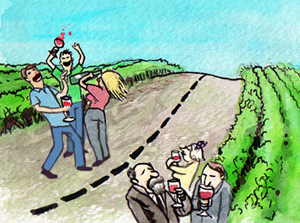

His generation savors the distinctiveness of wines that exhibit their unique regional characteristics. But he fears the new generation of wine drinkers don't care.
There’s a Wine Generation Gap
...I’ve fallen into it and can’t get out
by
Alan Goldfarb
April 8, 2008
 “Criticism,” the great poet W.H. Auden wrote, “is tradition defending itself against the three armies of Goddess Stupidity: the army of amateurs who are ignorant of tradition; the army of conceited eccentrics who believe tradition should be suppressed by a stroke of the pen in order that true art may begin with them; and the army of academicians who believe they maintain tradition by a servile imitation of the past.”
“Criticism,” the great poet W.H. Auden wrote, “is tradition defending itself against the three armies of Goddess Stupidity: the army of amateurs who are ignorant of tradition; the army of conceited eccentrics who believe tradition should be suppressed by a stroke of the pen in order that true art may begin with them; and the army of academicians who believe they maintain tradition by a servile imitation of the past.”
Thus, when it comes to criticizing many New World wines because of their penchant for imbalance, I’ve concluded that tradition is fast losing out to the growing army of new and young wine drinkers.
In other words, when it comes to wines of perfect pitch - that is, wine with good fresh fruit, substantial tannins, an evident
 wash of acidity, and heaven help us, a reasonable alcohol percentage - the subtleties of those criteria seem to have been lost. Gone, I’m afraid, into the abyss of what my peers used to refer to - in an earlier era - as the Generation Gap.
wash of acidity, and heaven help us, a reasonable alcohol percentage - the subtleties of those criteria seem to have been lost. Gone, I’m afraid, into the abyss of what my peers used to refer to - in an earlier era - as the Generation Gap.
At the beginning of a new century, we are once again entangled in a separation of the human species. But in this case, politics notwithstanding, that divide is now drawn along lines of wine preference.
As I delve into this diatribe, I admit that I’m audaciously taking to task those wines that evidently sell like nobody’s business - and that have their place in the market. Many seem to adore them, especially the constituency that comprises the other side of this Wine Generation Gap.
There is no doubt that these big, juicy wines, most of which are as sweet as the candy, iced tea and cola that younger consumers – being weaned off sugar drinks – are embracing. They deliver some sort of satisfaction that is being lost on an older chap such as me.
They are indeed sexy. But I tell you, when you’re finished making love with these over-wrought, blowsy, showy wines, I ascertain there’s nothing left to talk about. There’s no sitting-back-with-a-cigarette moment whilst ruminating on what has just taken place; and I like to talk about those pleasurable moments with my love on the pillow beside me.
I enjoy contemplating the vicissitudes of the day, just as I look forward to discussing the exigencies and the whys and wherefores of those terrific, complex wines that I’d just experienced that went perfectly with the lamb tagine and the crème brûlée.
Wine with food? Pairings? That’s so 20th century, you geezer you, they say. But to me, c’est incroyable that on more than one occasion, I’ve been told by “kids” in their 30s, “Wine with food? I never drink wine with food!”
I was raised with wine with food - wine I might add, that was well-made. We’re told, in platitudes now, that there’s better-made wine than ever; and “there’s all kinds of wines for everyone.”
But there’s less and less wine being made for a wretch such as me; at least not the kind of wine that I prefer. Although I make my living writing about an alcoholic beverage, I’m not a drinker. I don’t like alcohol for alcohol’s sake. I don’t like standing-up wines. I’d rather sit down with a glass or two and only as an accompaniment to food.
But, with these over-the-top, jam-jar, high-octane wines whose alcohol levels are routinely topping out at more than 15 percent, there is no intellectual discourse possible. It is what it is, as they say. Wines now are big and bold, so learn to live with it, old man; or stand aside, as my generation used to so brazenly shout.
So who am I to be critical of these now-era wines? I know it’s not all about the alcohol. If the grapes are picked with enough concentration, the alcohol can sometimes be well integrated. But many now are sending their wine to the fix-it shops to siphon off some of the high-test, which in the end is merely an anti-inflammatory.
In these pages on APPELLATION AMERICA recently, I asked George Hendry, who makes wine just below Mount Veeder in the Napa Valley, if we’ll ever see Zinfandel consistently at 14.5 alcohol. He answered succinctly: “Tell me what the market wants and I will figure out how to do it.”
So, I know that wines can be made with lower alcohol in California, and therefore, I know we can get back to balanced wines. I also know that, as those on the other side of the Wine Generation Gap will likely mature in time, so will their palates. And when that happens, they too will be looking for wines of distinction, complexity and nuance; and bottlings that we once called “food wines”.
I can’t wait for that to happen so that the market will swing back, as it usually does. But time isn’t on my side and I worry that the wine industry won’t be able to adjust swiftly enough and find its way again to making wines of discernment.










 READER FEEDBACK: To post your comments on this story,
READER FEEDBACK: To post your comments on this story,




